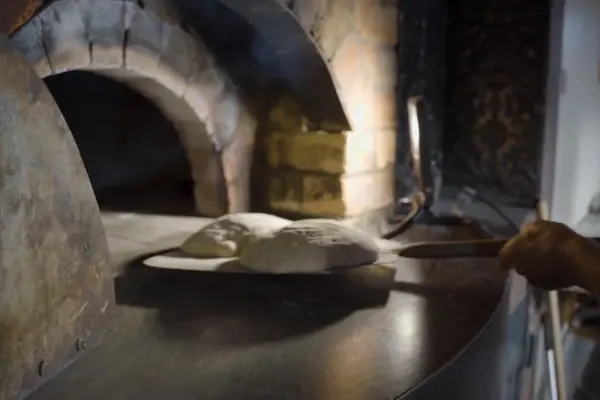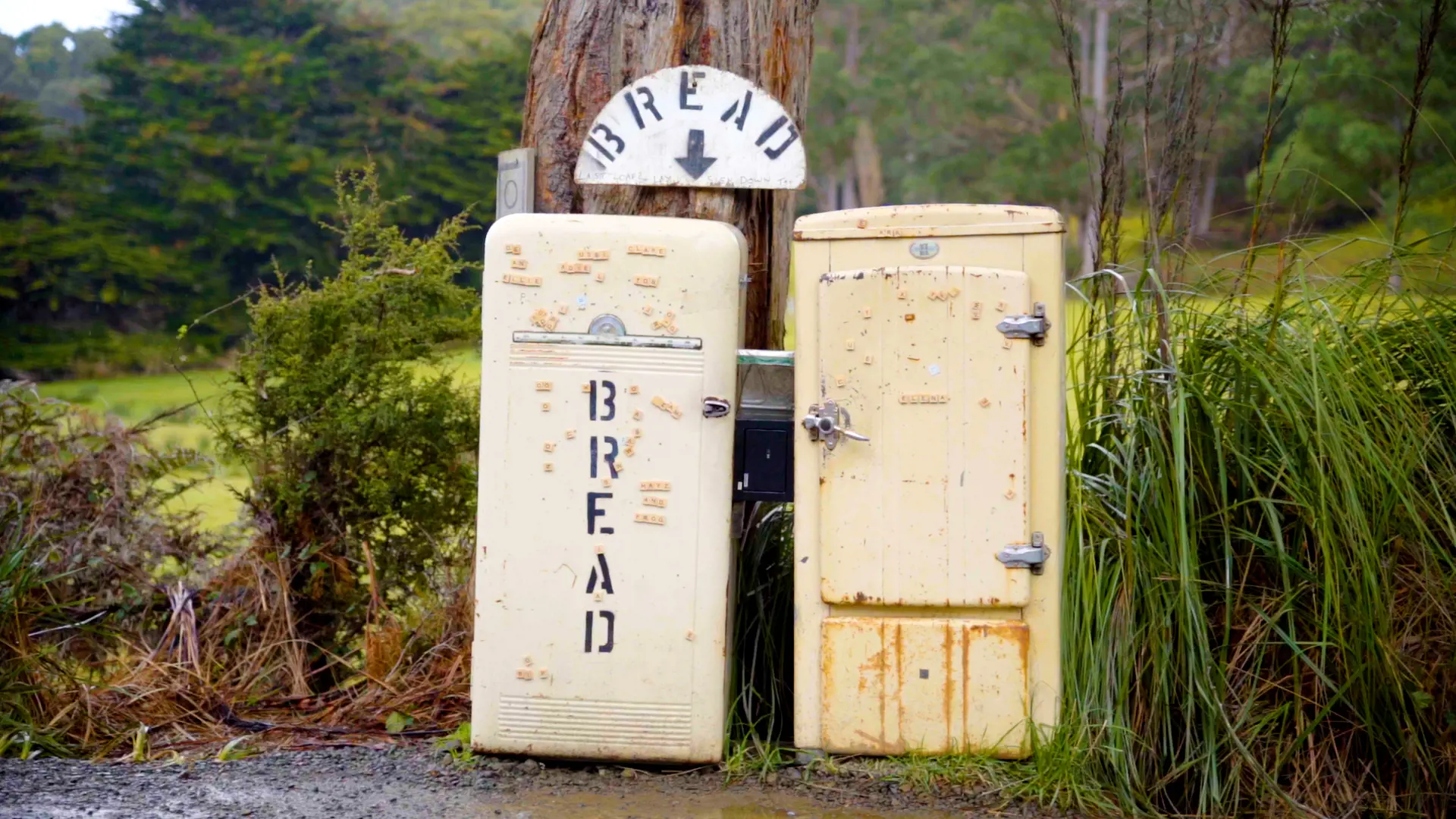
There’s a gentle rhythm to life on Bruny Island – from the waft of the day’s steaming sourdough to the soft cadence of nature’s cycles.
For John Bullock, aka the Bruny Baker, the days start early, stretching and turning his sourdough in preparation for baking in his wood-fired brick oven. The resulting loaves are destined for the Bread Fridge, a beloved roadside stall on South Bruny.
Each morning, Bullock stocks two retro fridges with crusty golden sourdough, spiced sultana and cinnamon loaves, and crunchy chocolate-coated Anzac biscuits, all of which disappear off the fridge shelves and into the cars of passers-by.
“I think one of the things that makes the bread popular is that it's always different, because I don't have any technology,” Bullock says. “I have to adjust my bread making and my timing every day.”
The Bread Fridge operates on an honesty system, which is something that Bullock says wouldn’t work just anywhere. But on laidback Bruny Island, a serene enclave off Tasmania’s south-east coast, it’s a success story.
“People are given the opportunity to be trustworthy – I think they like that,” Bullock says.
The feedback from customers is affirming, many leaving messages of appreciation using magnetic scrabble tiles stuck to the fridge.
There's a sense of contributing to the community, which I think helps to fuel my enthusiasm.
As well as supplying visitors and locals with fresh bread, Bullock and his partner Jenene Oates manage two cosy self-contained retreats overlooking the water at peaceful Sheepwash Bay – the rustic Shack and the luxurious Hide.
“Both of them are designed to offer people a different way of being…an experiential break and environmental change,” Oates says.
Hunt and gather: dining and diving on Bruny Island
Bruny Island is renowned for its abundant produce – the result of a creative and industrious local community.
“We usually suggest to people that they hunt and gather and have a picnic,” Bullock says. “Collect some oysters, some cheese, some olives, buy some wine, buy some cider…get some bread from the fridge, of course.”
“There's a maker’s market at Lunawanna every second Sunday,” Oates adds. “That's a really good place to gather local produce.”
Take your brimming picnic basket to sheltered Coal Point, on the road to Adventure Bay, for a scenic spot to feast. At low tide, peer into the large rockpools to spot darting fish and scuttling crabs. It’s also a top spot to catch abalone and crayfish if you have the appropriate licences.


Bruny’s fascinating aquatic life draws Oates and Bullock into the water regularly. They recommend packing snorkelling gear to make the most of this underwater haven.
“There’s also really accessible little reefs,” Oates says – including at Cemetery Beach, just north of Lunawanna, and just offshore from Hotel Bruny in Alonnah. Around the jetties at Adventure Bay, you might even be lucky enough to spot one of Bruny’s more elusive species – the weedy sea dragon.
On dry land, Bullock suggests fishing for salmon at the Neck: “I'm careless about whether I get them or not because it's so beautiful,” he says.


Natural connection: Bruny Island culture, wilderness and wildlife
There’s no disputing Bruny’s natural environment is show-stopping.
One of the best ways to explore it is bushwalking. Oates and Bullocks’ top picks? North Bruny’s 4hr, 13km Cape Queen Elizabeth track, which passes a striking coastal rock arch; the clifftop views from the 2.5hr, 4km Fluted Cape track, or the coastal gems along the 6hr, 18km Labillardiere Peninsula circuit, both in South Bruny National Park.
En route to Fluted Cape, keep an eye out for Bruny’s unusual white wallabies, which are regularly seen grazing at Adventure Bay. Other wildlife experiences are more cyclic in nature.


Those natural, seasonal rhythms, they all hold hidden gems.
Incredible ocean views draw visitors to the Neck, but it’s also a refuge for little penguins and a short-tailed shearwater (mutton bird) colony.
“To go there in mutton bird season when they’re landing would be quite something,” Bullock says.
Also at the Neck is a poignant memorial to Nuenonne woman Truganini. The palawa people’s long history is ever-present and there are important Tasmanian Aboriginal sites across the island, including cultural living sites in South Bruny National Park.
“Ancient history is everywhere,” Oates says.
For insight into historical South Pacific exploration and European explorers’ visits to Bruny Island, head to the captivating Bligh Museum in Adventure Bay.
As you head back to the ferry at the end of your weekend, sated by local produce and energised by the island’s natural delights, you’ll be hard pressed not to agree with Bullock when he says, there’s “so much to love about Bruny”.
Bruny Island FAQs
How to get to Bruny Island
Bruny Island is off Tasmania’s south-east coast. Access is by vehicle ferry, which departs from Kettering, 30min south of Hobart. The ferry trip takes 15–20mins and runs every 20 minutes throughout the day. The service operates on a queueing system – tickets are available at the ferry terminal or online but can’t be booked for specific times. Check the Sealink Bruny Island Ferry website for timetables and more information.
Where is the Bread Fridge on Bruny Island?
The Bread Fridge is a roadside stall on South Bruny. Find it on the corner of Bruny Island Main Rd and Sheepwash Rd, about 3km north-east of Alonnah. The stall consists of two retro fridges, which are stocked daily. Payment is via an honesty system and can be made by cash or bank transfer.
Where to eat on Bruny Island?
Bruny is renowned for its excellent produce, which draws visitors keen to sample local flavours, succulent seafood and creative tipples. After arriving on the island, head for Bruny Island House of Whisky for single malt tastings, just 3.5km from the ferry terminal. Continue south for cheese and beer at Bruny Island Cheese Co; a sweet and gooey fix at Bruny Island Honey Company; succulent summer berries at Bruny Island Raspberry Farm; and cool-climate wines at Bruny Island Premium Wines. Full yet?










